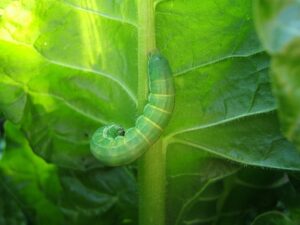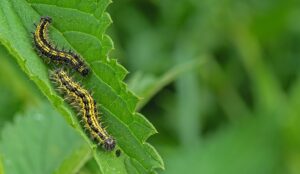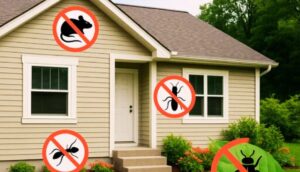How to Control and Prevent Cabbage Worms

Cabbage worm infestations have caused server devastation to leafy greens, these garden pests are common to many members of the cabbage family some of which include, kale, broccoli, cauliflower, and cabbage. Because of their huge appetite or feeding quick action must be taken to bring control. This worm family consists of cross-striped cabbage worms, imported cabbageworm, diamondback moth larvae, and Cutworms. Larvae are more manageable or easy to control when they’re small.
Successful control measures first depend on the proper identification, the type of pesticide that is used, how that pesticide ( read and follow the manufacturer’s directions according to the label) is used, and the timing of pesticide application. Different species of caterpillars may be more vulnerable or susceptible to various pesticides.
Signs of Cabbage Worms
If you notice small white butterflies with black wing spots in your garden then it is time to take quick action to bring control, the female lays her eggs on the leaf’s undersides so this is where your inspection should take place first. The tiny eggs resemble footballs, are golden, and are attached by their tips. The caterpillars look like worms 1-inch long, green in color, and are covered with fine hairs which cause them to have the appearance of velvet. Lines that are pale yellow run lengthwise down their bodies.
Methods to Prevent Cabbage Worms
Whether you’re growing an edible garden or ornamental plants one thing is for sure and that’s keeping a garden that’s properly maintained, the reason being a healthy garden will be more resistant to disease and garden insect pests.
- Make sure that garden plants are getting the required sunlight, water, and fertilizer but what is equally important is that your garden plants are planted in the right soil type.
- Incorporate plants that will encourage beneficial insects or natural predators insects that use garden insect pests as a food source.
- The use of a row cover or cheesecloth that’s porous and breathable can cover them effectively. Row cover or cheesecloth will discourage moths from laying their eggs on the leaves.
- Garden soil should be amended with compost, aged manure, organic matter, or other soil amendments.
- Keep your garden free of weeds because weeds will compete with garden plants for sunlight, nutrients, and water. Weeds also harbor garden insect pests and some weeds are known to be carriers of diseases.
- When pruning, prune at the right time of the year for that plant species and ensure you’re pruning correctly.
- Keep your pruner sharp and sterilized, and make sure that other garden tools are cleaned as well.
- Make sure to remove diseased plant parts and sterilize your pruner, pruning saw and lopper shears after each pruning procedure to control the spread of disease.
Keep Cabbage Worms Away with Companion Planting

The use of companion planting is an effective method that has been around for a long time and is used in many home gardens, this all-natural technique works by interplanting plant species with garden plants to deter (they hate the scent these plants produce) garden insect pests. For the control of cabbage worms here are just a few plants to install.
- Peppermint
- Thyme
- Tomatoes
- Marigolds
- Tansy
Other Methods of Cabbage Worm Control
Other safe approaches can be taken to control cabbage worms without contaminating the environment or killing off beneficial insects with harmful pesticides.
- When inspecting your plants if you come across eggs and worms or larvae pick them off and place them in a container of soapy water to eliminate. If you like wearing a pair of disposable gloves will help also, make this a regular part of your garden maintenance program.
- The application of neem oil is a great choice, this natural organic spray is safe on edible crops and will control cabbage worms, other garden insect pests that come in contact with neem oil will be eliminated as well. However, before spray application read and follow the manufacturer’s directions for the best results.
- In the case of heavy infestation apply BT every 1 to 2 weeks, remember before applying read and follow the manufacturer’s directions for the best results.
- Yellow sticky traps are effective in the capture of the adult month before the female has a chance to lay her egg. Place these traps in your garden, aware that beneficial insects might also fall prey to these traps.
-
Diatomaceous Earth or DE is ground-up fossilized seashells. this sand-like mixture punctures the insects’ bodies (both soft-bodied and insect with exoskeletons ), causing dehydration followed by death.
Additional information
- Remember to read and follow the manufacturer’s directions for the correct mixture.
- Plants should be sprayed during the early evening hours to prevent plant burn from the sun besides spraying during the even hours will also protect beneficial insects and pollinators that are most active during the morning and day hours.
- Do not attempt to spray plants if rain is forecast.
- When spraying get full coverage of but the surface and the undersides of the plant’s leaves.
- The spray should be applied fine and misty, not coarse dropping which will be infected.
Conclusion
The control of cabbage worms may take a little effort on your part but the time spent will be worth the effort as the cabbage moth and the larvae are eliminated. These methods have been tried and tested and have proven to give the best results. If you have a cabbage moth issue then what was discussed will help you to bring complete control that will not only deter the cabbage moth but will reward you with a healthy garden that will enable you to reap the rewards of your labor.










The practical tips for applying treatments and managing infestations are also very helpful. It’s good to have a range of strategies, from manual removal to using organic solutions like neem oil, to address different levels of pest activity. This balanced approach can make a real difference in keeping those pesky worms at bay.
I am so happy to help, thanks so much for stopping by and commenting.
I really appreciated your article on how to get rid of cabbage worms! You made the whole process so straightforward, especially with the natural remedies you suggested. The tip about using neem oil was super helpful—I’ve been looking for a more eco-friendly way to protect my garden. I’m curious, though, how often do you recommend applying the neem oil for it to be most effective? Also, do you have any advice on preventing these pests from coming back once I’ve got them under control? Thanks for sharing such practical and easy-to-follow advice!
You can apply neem oil every 7- to 14 days, once or twice a week is sufficient, or read the manufacturer’s label. The answer to your second question can be found in my post. I am happy to help and thanks for your kind words.
https://bugoffcontrol.com/how-…
Great tips on controlling and preventing cabbage worms! It’s so frustrating to see a beautiful garden suddenly overrun by these pests, but your suggestions provide a solid plan of action. I love the emphasis on natural methods like companion planting and using neem oil—it’s a great way to keep the garden healthy without harming beneficial insects or the environment. And those practical tips on maintaining garden tools and timing sprays correctly are super helpful! Thanks for sharing these insights; I’m sure they’ll be a game-changer for anyone dealing with cabbage worms in their garden!
Yes, garden pest will seek to rob us of our harvest but a well thought out plan by using these natural methods will work wonders by brining control. I am so happy to help and thanks so much for your kind words.